Today, I am sharing Carolina Chickadee photos, plus a Trumpet Vine Sphinx moth that was on the driftwood where the chickadee landed two days ago in Arkansas.
 Carolina Chickadee and a Trumpet Vine Sphinx moth – Canon R7, handheld, f7.1, 1/500, ISO 3200, +0.3 EV, Canon 100-400mm at 400mm, natural light
Carolina Chickadee and a Trumpet Vine Sphinx moth – Canon R7, handheld, f7.1, 1/500, ISO 3200, +0.3 EV, Canon 100-400mm at 400mm, natural light
Steve Creek and I noticed the moth on the driftwood earlier while photographing a Downy Woodpecker. I was kind of hoping a bird would fly close to it, and this chickadee obliged.
I don’t think the chickadee planned on making a meal of the moth because it was so large compared to the small bird, but who knows for sure?
 Trumpet Vine Sphinx moth and a Carolina Chickadee – Canon R7, handheld, f7.1, 1/500, ISO 3200, +0.3 EV, Canon 100-400mm at 400mm, natural light
Trumpet Vine Sphinx moth and a Carolina Chickadee – Canon R7, handheld, f7.1, 1/500, ISO 3200, +0.3 EV, Canon 100-400mm at 400mm, natural light
The large sphinx moth and little chickadee side by side made for interesting photos. Not long after I took this image, I got distracted by another chickadee at the top of the driftwood, and by the time I focused on the moth again, this chickadee had flown off.
 Trumpet Vine Sphinx moth close up – Canon R7, handheld, f8, 1/160, ISO 1250, Canon 100-400mm at 400mm, natural light
Trumpet Vine Sphinx moth close up – Canon R7, handheld, f8, 1/160, ISO 1250, Canon 100-400mm at 400mm, natural light
Before I took the photos of the chickadee with the moth I had walked out to take close up photos of it. At that time I didn’t know the identity of the moth so I wanted clear photos of it to assist me with that. I knew it was a sphinx moth but nothing more than that.
I used Google lens and then iNaturalist to verify the Trumpet Vine Sphinx identification.
 Trumpet Vine Sphinx moth side view – Canon R7, handheld, f8, 1/125, ISO 1250, Canon 100-400mm at 400mm, natural light
Trumpet Vine Sphinx moth side view – Canon R7, handheld, f8, 1/125, ISO 1250, Canon 100-400mm at 400mm, natural light
An interesting fact about Trumpet Vine moths is that they play a crucial role in pollination, helping to fertilize the trumpet vines and other flowering plants they visit, thus supporting the ecosystem in which they live.
I missed seeing the moth fly away from the driftwood. I believe it happened when the bright morning sunlight lit up the driftwood.
Pay attention pays off, over and over again.
Life is good.
Mia
Check here to see more of my Carolina Chickadee photos plus facts and information about this species. Click here to see my insect and spider galleries.


The Chickadee certainly appears to be thinking about having lunch…but wisdom prevailed. It is fascinating how well the Trumpet moth blends into the driftwood. Terrific pics. Thanks Mia.
That is an enormous moff. I don’t think we have the sphinx moths here – but will have to explore. And the chickadee is enchanting.
I had a monarch in the yard yesterday, it was hovering over my flowers, it looked like it had a tag, the wing tag was on the other side from me. I was hoping it would turn and land so I could see it better and get a photo. Just as it turned and my camera was locking focus two, of the many chickadees in my yard, went after the butterfly. The butterfly took evasive moves as the two birds chased it. They ziged and zaged and flew up high over the trees and neighbors garage, and into the gully. The birds gave up chase and returned to sit in the tree the butterfly flew over.
Could it be its camouflage that saved the moth? In any case, the dark dorsal line that lines up exactly with a rift in the wood, some of its white spots looking identical to those on the tree– are amazing!